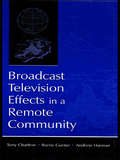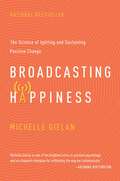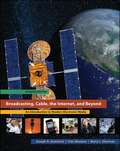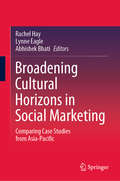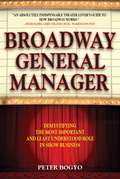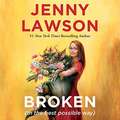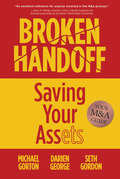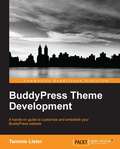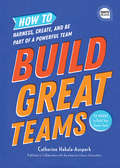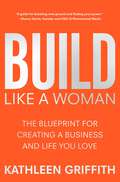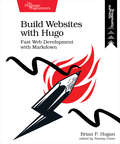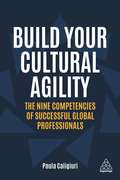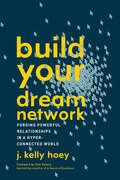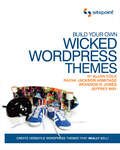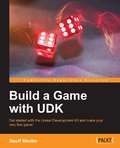- Table View
- List View
Broadcast Rites and Sites: I Saw it on the Radio with the Boston Red Sox
by Joe Castiglione Douglas LyonsVeteran broadcaster Joe Castiglione has seen his share of heartbreaking games, especially from his vantage point at Fenway Park where he has called the Red Sox games for the last 20 years. In his newest book, Castiglione not only recounts the drama from the booth in Boston, but also his travels and baseball adventures throughout the country in his previous stints with the Cleveland Indians and Milwaukee Brewers over his 30-year career.
Broadcast Television Effects in A Remote Community (Routledge Communication Series)
by Barrie Gunter Tony Charlton Andrew HannanThis book reports findings from a major, multidisciplinary study of the impact of broadcast television on the remote island community of St. Helena in the South Atlantic Ocean. Broadcast television was introduced to the island for the first time in March 1995. This introduction represented a major event on the island, whose only televisual experience had been through video. In the years leading up to the introduction of TV, the researchers who wrote this book collected data by observing the island's young children in classroom settings, and during free-play. In addition to these observations they asked the children's teachers to rate their students' behavior, and invited the children to explain to them what leisure time activities they engaged in. With the data they were able to amass on these key variables they have assembled and coded the results into baseline measures central to the study. Once TV had arrived, they collected data annually on the key dependent measures to determine if the introduction of broadcast TV had any discernible influence on the behavior of the children.
Broadcasting Happiness: The Science of Igniting and Sustaining Positive Change
by Michelle GielanBroadcasting Happiness will "inspire you and change your life." —Parade Magazine We are all broadcasters. As managers, colleagues, parents and friends, we are constantly transmitting information to the people around us, and the messages we choose to broadcast create success or hold us back. What's your broadcast? New research from the fields of positive psychology and neuroscience shows that small shifts in the way we communicate can create big ripple effects on business and educational outcomes, including 31 percent higher productivity, 25 percent better performance ratings, 37 percent higher sales, and 23 percent lower levels of stress. In Broadcasting Happiness, Michelle Gielan, former national CBS News anchor turned positive psychology researcher, shows you how changing your broadcast changes your power by sharing jaw-dropping stories and incredible research. Learn Michelle's simple research-based communication habits that have been featured in her PBS program Inspire Happiness and Oprah's 21 Days to Happiness class. Broadcasting Happiness will help you: - Inoculate your brain against stress and negativity by fact-checking challenges - Drive success by leading a conversation or communication with positivity - Rewrite debilitating thought patterns and turn them into fuel for resilience and growth - Deal with negative people in a way that lessens their power - Share bad news more effectively to increase future social capital - Create and sustain a positive culture at work or home by creating contagious optimism - Help the people you care about most move from negative to positive in seconds Broadcasting Happiness showcases how real individuals and organizations have used these techniques to achieve results that include increasing revenues by hundreds of millions of dollars, raising a school district's graduation rate by 45 percent, and shifting family gatherings from toxic to thriving. Changing your broadcast can change your life, your success, and the lives of others around you. Broadcasting Happiness will show you how!
Broadcasting Hollywood: The Struggle Over Feature Films on Early TV
by Jennifer PorstBroadcasting Hollywood: The Struggle Over Feature Films on Early Television uses extensive archival research into the files of studios, networks, advertising agencies, unions and guilds, theatre associations, the FCC, and key legal cases to analyze the tensions and synergies between the film and television industries in the early years of television. This analysis of the case study of the struggle over Hollywood’s feature films appearing on television in the 1940s and 1950s illustrates that the notion of an industry misunderstands the complex array of stakeholders who work in and profit from a media sector, and models a variegated examination of the history of media industries. Ultimately, it draws a parallel to the contemporary period and the introduction of digital media to highlight the fact that history repeats itself and can therefore play a key role in helping media industry scholars and practitioners to understand and navigate contemporary industrial phenomena.
Broadcasting and the NHS in the Thatcherite 1980s
by Hugh Chignell Patricia Holland Sherryl WilsonPatricia Holland offers a fascinating study of the ways in which changes to public services, and shifts in the concept of 'the public' under Margaret Thatcher's three Conservative governments, were mediated by radio and television in the 1980s.
Broadcasting, Cable, The Internet, And Beyond: An Introduction To Modern Electronic Media
by Joseph R. Dominick Barry L. Sherman Fritz J. MessereThis survey of the field of modern electronic media includes the new technologies, regulations, programming, and competition that affect our world and the broadcasting industry. The text conveys the excitement of the industry in a highly accessible style that makes even the most difficult information understandable.
Broadening Cultural Horizons in Social Marketing: Comparing Case Studies from Asia-Pacific
by Lynne Eagle Rachel Hay Abhishek BhatiThis book presents a series of empirically based case studies conducted by social change scholars from Asia-Pacific, showcasing the latest social marketing approaches geared at improving societal well-being in the region. Cutting across cultural perspectives, the contents gather ideas on social marketing campaigns and strategies from around the region and use these case studies as a platform to address concomitant challenges in employing marketing tools to positively change social behaviour. The selection of case studies covers and compares aspects of public health and well-being, and public environmental consciousness in terms of driving attitudes towards implementing improved sustainability in developing and developed countries. Drawing on related policies and legislation, and examining social behaviour at the individual, community, and organisational levels, the authors propose innovative new methods in social marketing and social change research. The book is of interest to researchers and practitioners in social marketing, business ethics, behavioural science, public health, and development studies.
Broadway General Manager: Demystifying the Most Important and Least Understood Role in Show Business
by Peter Bogyo“An absolutely indispensable theater lover’s guide to how Broadway works.” —Peter Marks, chief theater critic, Washington Post“Highly recommended for those considering theater as a career and for those who love theater and want to know more about what goes on before the curtain goes up and after.” —Library JournalBroadway General Manager is a fascinating, insightful, and entertaining glimpse into the normally closed world of theatrical general management. Penned by veteran Broadway insider Peter Bogyo, readers will gain an appreciation and understanding of what the business half of show business is all about. For the first time ever, gain backstage access to the fast-paced and glamorous world of Broadway. Broadway General Manager is an invaluable resource that examines actual production and operating budgets for a Broadway show and shares contracts for award-winning actors, directors, and designers, all of which are analyzed extensively. Also included are in-depth discussions on such topics as:How to get started as a general manager Negotiating contracts How the producing entity functions Programming the box office The issues related to hiring employees Binding insurance Financial overview Maintaining the run of a show What to do when sales start to slump Closing a show And much more Laced with humorous insights and personal anecdotes, Broadway General Manager will delight both the average theater lover as well as individuals with a serious interest in commercial arts management.
Broke Millennial Talks Money: Scripts, Stories, and Advice to Navigate Awkward Financial Conversations
by Erin LowryA comprehensive guide to talking about money in every aspect of your life, including at work, with friends and family, and in relationships, from the author of the Broke Millennial series.Let's face it--talking about money is always awkward. In this user-friendly and approachable guide, finance writer Erin Lowry helps take the stress out of these tricky conversations. With scripts, tips, and troubleshooting advice, she takes you through every possible money talk scenario, including: • how to tell your friends you can't afford the same lifestyle they can • how to ask your parents if they can afford retirement and if they'll need your support as they age • how to talk to your coworkers about your salary and negotiate with your boss • how to broach the subject of a prenup with your fiancé Lowry arms you with all of the financial knowledge you'll need in order to get the most out of each interaction, whether that's with your friends, your spouse, your employer, or your mom. It's time to demystify our money and hash out these tough topics with the important people in our lives, and this helpful book will make it all much easier.
Broken (in The Best Possible Way)
by Jenny Lawson"Jenny Lawson returns to narrate her third installment in a disheveled saga of finding the light at the end of a long, winding, ludicrous tunnel.... Another treasure in the Lawson collection, this audiobook shines with a powerful message: Depression and anxiety suck, but we can rise above them." (AudioFile Magazine, Earphones Award winner) From the number one New York Times best-selling author of Furiously Happy and Let’s Pretend This Never Happened comes a deeply relatable audiobook filled with humor and honesty about depression and anxiety. *This program includes an audio-exclusive bonus chapter* As Jenny Lawson’s hundreds of thousands of fans know, she suffers from depression. In Broken (in the bests possible way), Jenny brings listeners along on her mental and physical health journey, offering heartbreaking and hilarious anecdotes along the way. With people experiencing anxiety and depression now more than ever, Jenny humanizes what we all face in an all-too-real way, reassuring us that we’re not alone and making us laugh while doing it. From the business ideas that she wants to pitch to Shark Tank to the reason why Jenny can never go back to the post office, Broken leaves nothing to the imagination in the most satisfying way. And of course, Jenny’s long-suffering husband Victor - the Ricky to Jenny’s Lucille Ball - is present throughout. A treat for Jenny Lawson’s already existing fans, and destined to convert new ones, Broken is a beacon of hope and a wellspring of laughter when we all need it most.
Broken Handoff: Saving Your Assets
by Michael Gorton Darien George Seth Gordon“Read this page turner to know what to do and—as importantly—what not to do in M&A. You will be glad you did.” —Mark Victor Hansen, coauthor and co-creator of The One Minute Millionaire and Chicken Soup for the SoulEvery year, more than fifty thousand deserving entrepreneurs and executives attempt to sell a company they’ve worked tirelessly to build—yet more than 70 percent fail. Why? Because most deals are derailed by hidden dangers that leave both buyers and sellers blindsided.Broken Handoff: Saving Your Assets is a breakthrough book with rare and remarkably transparent insights into owning, buying, and selling a business. Exposing unexpected pitfalls and revealing hands-on solutions for the mergers and acquisitions process, Broken Handoff delivers tools to beat the odds and broker the deal you want. This definitive guide to business-ownership transactions is required reading for founders, CEOs, venture capitalists, mentors, and moguls.“Losses from M&A transactions that fall short of expectations represent an opportunity of $3 trillion a year. Broken Handoff clearly addresses the vulnerabilities and shortcomings that cause these failures—and, more importantly, advances viable solutions. This book should be read by everyone anticipating an M&A transaction, funding, or liquidity event.” —James Keyes, former CEO of 7-Eleven and Blockbuster, Horatio Alger recipient“Smashes through the financial and theoretical rhetoric of M&A success and failures. Filled with insights and lessons learned from the school of hard knocks, this book should be required reading for all parties in the M&A dance—especially those seeking to avoid a postmerger cultural collision and declining productivity.” —Michael Schornstein, startup founder, CMO, advisory board member of CommandHound
Broken News: Why the Media Rage Machine Divides America and How to Fight Back
by Chris Stirewalt"One of America&’s most experienced and exemplary journalists has written an unsparing analysis of the dreadful consequences -- for journalism and the nation -- of &‘how the news lost a race to the bottom with itself.&’&” -- George F. Will In this national bestseller, Chris Stirewalt, a former Fox News political editor, takes readers inside America&’s broken newsrooms that have succumbed to the temptation of &“rage revenue.&” One of America&’s sharpest political analysts, Stirewalt employs his trademark wit and insight to reveal how these media organizations slant coverage – and why that drives political division and rewards outrageous conduct. The New York Times wrote that Stirewalt&’s book "is an often candid reflection on the state of political journalism and his time at Fox News, where such post-mortem assessments are not common..." Broken News is a fascinating, deeply researched, conversation-provoking study of how the news is made and how it must be repaired. Stirewalt goes deep inside the history of the industry to explain how today&’s media divides America for profit. And he offers practical advice for how readers, listeners, and viewers can (and should) become better news consumers for the sake of the republic.
Brooklyn in Love: A Delicious Memoir of Food, Family, and Finding Yourself
by Amy ThomasFrom the author of Paris, My Sweet comes the story of a modern woman embracing love, motherhood, and all the courses life has to offer,On an island where finding love can be just as hard as finding a dinner reservation on a Friday night, Amy Thomas never imagined a family would fit into her lifestyle. So when Amy finds herself turning forty, moving to Brooklyn, and making way for a baby with a new man in her life, she realizes that starting over may be her biggest opportunity yet.But how do you balance staying out all night dancing with staying up all night soothing a baby? Can a lifelong city girl trade in spontaneity for domesticity? Set amid the backdrop of Brooklyn and Manhattan's foodie scenes, Amy sets out to make her second act even sweeter than the first.
Brutalisierung und Banalisierung: Asoziale Und Soziale Netze (Essentials)
by Peter LudesPeter Ludes entlarvt Brutalisierung und Banalisierung in kollektiven Mythen – für eine Emanzipation der Sinne im Zeitalter ihrer technischen Vereinnahmung. Denn Informations- und Kommunikationstechnologien dienen nicht nur der Ausweitung von Kommunikation, sondern auch als Kampfmittel. Insoweit sie aufgrund ihrer leicht zugänglichen, scheinbar kostenlosen Verbreitung als relativ natürliche Weltbedingungen erlebt werden, konstituieren sie neue Mythen der unbegrenzten, freien Kommunikation. Welche Perspektiven und Praktiken werden aber wie vorgegeben und formatiert? Wie wird das komplexe und widersprüchliche Zusammenspiel und Gegeneinander von fiktiven Behauptungen und verdrängten ‚Tat-Sachen‘ zu einem neuen Problem? Es geht zum Schluss um unterschiedlich vernetzte lokale Kontakt- und globale virtuelle Machtzonen, die hier symbolisch aufgehoben werden mit Abrechnungen für die acht reichsten Männer der Erde.Der Autor Dr. Peter Ludes, PhD (USA), habilitierter Soziologe, apl. Professor für Kultur- und Medienwissenschaft in Siegen. Professor für Massenkommunikation an der Jacobs University Bremen 2002-2017, Gastprofessor an der Universität Köln.
Bryson's Dictionary for Writers and Editors
by Bill BrysonFrom one of America's most beloved and bestselling authors, a wonderfully useful and readable guide to the problems of the English language most commonly encountered by editors and writers.What is the difference between &“immanent&” and &“imminent&”? What is the singular form of graffiti? What is the difference between &“acute&” and &“chronic&”? What is the former name of &“Moldova&”? What is the difference between a cardinal number and an ordinal number? One of the English language's most skilled writers answers these and many other questions and guides us all toward precise, mistake-free usage. Covering spelling, capitalization, plurals, hyphens, abbreviations, and foreign names and phrases, Bryson's Dictionary for Writers and Editors will be an indispensable companion for all who care enough about our language not to maul, misuse, or contort it.This dictionary is an essential guide to the wonderfully disordered thing that is the English language. As Bill Bryson notes, it will provide you with &“the answers to all those points of written usage that you kind of know or ought to know but can&’t quite remember.&”BONUS MATERIAL: This ebook edition includes an excerpt from Bill Bryson's One Summer.
Buck Up, Suck Up . . . and Come Back When You Foul Up: 12 Winning Secrets from the War Room
by James Carville Paul BegalaThe political strategists who directed the Clinton campaign's War Room reveal the lessons and secrets from their hard-fought battles -- and how to use these highly effective strategies for success in everyday life. James Carville and Paul Begala have waged political war all across America and on three continents. They've won some of the most spectacular political victories of the twentieth century and lost a few campaigns too. Along the way, they've learned a few lessons. Some sound simple, like "Never Quit," some comic, like "Kiss Ass," and some are more complicated and nuanced, like "Strategy Ain't Tactics." But each lesson contains tried-and-true wisdom, illustrated with colorful stories from long political experience -- many never told before: Find out how Carville's mother, Miz Nippy, used a bass boat to "frame the debate" in selling encyclopedias. Discover what success secret Hillary Rodham Clinton and Tom DeLay share. Learn the War Room tricks for sharpening your message and delivering the perfect sound bite. And much more. Whether you are a senior executive or a secretary, a political junkie or the president of the United States, the rules to live by can be found in Buck Up, Suck Up...and Come Back When You Foul Up.
BuddyPress Theme Development
by Tammie ListerThis book is a hands-on tutorial guide to using BuddyPress.This book is great for designers and developers who are looking to learn how to develop BuddyPress themes. It's assumed that the reader has some understanding of Wordpress and is familiar with CSS and HTML.
Buenos modales. Mejores negocios: Cómo desenvolverse con éxito dentro y fuera de la empresa
by Edith CortelezziUn libro necesario para todo aquel que quiera sobrevivir y destacarse en el ambiente empresarial y social con el conocimiento de las reglas protocolares como herramienta. En el mundo de hoy -donde todo es rápido y vertiginoso- el éxito tanto en el ámbito empresarial como social nos exige estar lo más preparados que nos sea posible. A la hora de buscar trabajo o de desempeñarse satisfactoriamente en el ámbito laboral, las personas no tienen dudas acerca de la importancia de contar con un título universitario, cursos y posgrados que garanticen y realcen sus destrezas. En este contexto, ciertos atributos que parecen pasados de moda deben ser reafirmados. Uno de ellos es el protocolo. La primera intención de este libro es desmitificar la idea de que el protocolo solo es para diplomáticos. Nada más alejado. Muchas veces no sabemos expresar lo que queremos decir, nos ganamos por torpeza la antipatía de otros, hablamos cuando deberíamos hacer silencio o nos callamos cuando están esperando una respuesta de nuestra parte. Otras veces, el desconocimiento de las formas nos hace trastabillar en los momentos clave. Saber comportarse en todas las circunstancias es un arte que puede aprenderse y nos llevará directo al éxito. Este libro brinda toda la información necesaria para desenvolvernos en situaciones complejas. A través del manejo y el cuidado de los modales, otorga la seguridad necesaria para negociar con un cliente, convivir cordialmente con nuestros pares y ser justos con nuestros subalternos. Nos da herramientas para mantener una conversación interesante, saber mirar a nuestro interlocutor, asistir a una cena o ser un buen invitado. Con un lenguaje ameno y descontracturado, Edith Cortelezzi nos demuestra que todo es posible cuando se conocen las reglas.
Build Great Teams: How to Harness, Create, and Be Part of a Powerful Team (Ignite Reads)
by American Library AssociationIn partnership with the American Library Association (ALA), Build Great Teams provides a 52-week guide to creating your dream team—and accomplishing each of your goals along the way!Teamwork matters. Most of us realize the immediate impact of being on a strong, cohesive and harmonious team. But how do you A) establish a powerhouse team; B) develop successful teamwork skills; and C) turn a troubled team around?In just one year (or 52-weeks), you can achieve your personal dream team through Catherine Hakala-Ausperk's proven program. Organized in 52 modules, designed to cover a year of weekly sessions but easily adaptable for any pace, this work covers major management topics such as success with recruiting, ensuring roles are successful, team communication, establishing an innovative team, and more!
Build Like A Woman: The Blueprint for Creating a Business and Life You Love
by Kathleen GriffithFrom the self-made businesswoman and founder of the global platform Build Like A Woman comes the essential resource to unleash your business, take up space, and create your dream life.In a world of hustle culture and burnout, women don’t want to lean in, they want to lie down. Now more than ever, women are looking to leave the corporate grind to break out into their own entrepreneurial ventures in a way that feeds their life rather than consumes it. But they don’t know exactly where to start.Kathleen Griffith has been in these exact shoes. When she set out to launch her own business she found that the women’s business space was big on “go, girl” messages, but short on the gritty details of actually building a business. So she taught herself everything she could, learned from the best minds in business and coached with personal growth experts. She realized, shockingly, that all the “mindset” work paid the highest dividends of all in her business, and that through this process she had developed a proven method for success.Blending foundational mindset tenets with the practical, actionable, business-building skillsets, Build Like A Woman is for aspiring and existing entrepreneurs who want to start and scale a business AND life they love. From corporate dropouts to side hustlers to recent college grads to full-fledged founders. This is not a regular business book, but an unconventional blueprint for creation. It will shake up any belief that’s holding you back, remove any barriers standing in your way and unlock your full potential. Tools you’ll get to break ground in business and break through in life:● Life Design● Wellness Practices ● Personal Power ● Mindful Leadership ● Money Management ● Customer Target● Brand Strategy● Marketing Plan● Sales Pitch Are you ready to BUILD? Let’s dig in.
Build Websites with Hugo: Fast Web Development With Markdown
by Brian P. HoganDatabase-driven sites bring complexity you might not need, but building a site by hand is too much work. Hugo is a static site generator and web development framework that creates content sites quickly without the overhead or dependencies of a dyanmic web framework. With Hugo, you use HTML templates and Markdown to build static sites you can host anywhere, letting you use the skills you already have. Develop your own theme using standard HTML and CSS, using Hugo’s powerful templating features to organize your site’s components. Create your site’s content with HTML or Markdown and use Hugo’s content templating features to build new content quickly. Build a fully-featured blog with archive pages, tagging, and pagination, and integrate an external commenting system to provide interactivity. Use data from front-matter, site-wide configuration, and external JSON sources to add content, and generate JSON others can use. Integrate JavaScript with your site to create a search engine. Get Hugo working with Webpack so you can leverage the wider web development ecosystem, and explore ways to publish your site to various services. Finally, learn how you can move your existing content site to Hugo. Dive in and build your next site with Hugo!
Build Your Cultural Agility: The Nine Competencies of Successful Global Professionals
by Paula CaligiuriThe investment in global collaboration technology now exceeds US$45 billion. Professionals who work across cultures face some of the most cognitively, psychologically and emotionally difficult challenges, regardless of whether they work virtually or in person. And they often face these challenges without the help of a corporate guide. Build Your Cultural Agility is that guide. This book offers strategies to help you develop into a successful global professional, one who can comfortably and effectively work in and with people from different cultures. This book helps you leverage your natural strengths while providing suggestions for developing cultural agility competencies. Build Your Cultural Agility focuses on nine specific competencies that comprise cultural agility: three self-management competencies (tolerance of ambiguity, curiosity and resilience), three relationship-management competencies (humility, relationship-building and perspective-taking) and three task-management competencies (cultural minimization, cultural adaptation and cultural integration). Within each chapter, the author provides a case example of that competency in action, explains why the competency is critical for success, offers a self-awareness exercise to help you determine your level of proficiency and concludes with suggestions for self-development.
Build Your Dream Network: Forging Powerful Relationships in a Hyper-Connected World
by Kelly HoeyCut through the networking noise and start building the powerful, real relationships needed to succeed in our digital world If you think of networking as schmoozing at boring cocktail parties or scrolling through LinkedIn for new contacts to add, think again. In the social media age, you need a modern roadmap for creating and cultivating meaningful connections to stand out from the crowd and achieve any of your goals, no matter how big or small. In Build Your Dream Network, acclaimed business columnist and networking expert J. Kelly Hoey offers a fresh new approach to mastering this timeworn skill in a world where everyone is posting, liking, and friending fast and furiously, but many are failing to leverage their connections successfully. Hoey presents innovative strategies for forming strong relationships—the genuine, mutually beneficial, long-lasting kind—using all of the social tools at your disposal. She also reveals creative and surprisingly simple ways to harness the power of your network to accomplish any ambition, from landing your dream job or a coveted account or client to successfully crowdfunding a new business venture. Build Your Dream Network will help you: • Determine the most effective ways to connect with others so you don’t clutter your calendar with dead-end coffee dates and informational interviews • Synchronize IRL networking efforts with your digital outreach • Turn “closed door” conversations into strong personal relationships and business opportunities • Eliminate FOMO by keeping your networking efforts focused Packed with infographics, flowcharts, and encouraging advice, Build Your Dream Network shows how small adjustments in your daily routine, generosity, and goal-focused efforts are all it takes to set you apart and ignite the powerful connections that will lead to major opportunities for success.
Build Your Own Wicked Wordpress Themes: Create Versatile Wordpress Themes That Really Sell!
by Alan Cole Raena Jackson Armitage Brandon R. Jones Jeffrey WayWicked WordPress Themes is a step-by-step guide to creating beautiful themes for the world's most popular CMS, WordPress.By following the book's advice, readers can produce designs that are aesthetically stunning, consistent, and for-purpose -whether it's for their own use, or to drive a high price on the theme marketplace.All facets of theme design are covered: from design, coding, and deployment, to ensuring readers' designs are ready-to-go as soon as they're installed. Wicked WordPress Themes teaches readers how to leverage theme design frameworks to dramatically shorten development time, enabling them to enter the theme market faster.
Build a Game with UDK
by Geoff ShollerA step-by-step tutorial to create an astounding game using the tools provided by UDK.This book is intended for people who aim to make an amazing virtual game with UDK. The goal of this book to give users a chance to expand their knowledge and create exciting games using the tools available.

